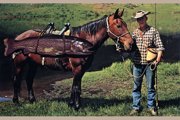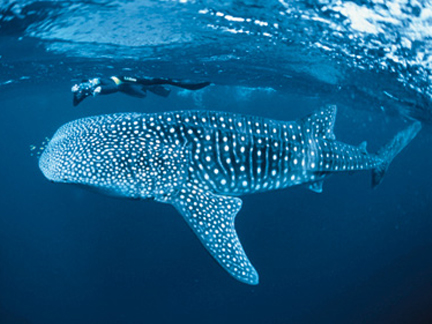
May 3, 2009
Phyllis Mancz of Ohio has sent in a scan of another postcard that might be viewed by some as another mystery fish photograph. Or others might assume it is a funny hoax item, one seen in tourist-laden places like Florida almost a century ago, available to send back home to Aunt Dorothy with a minute-tall-tale hastily written on the back of the card.

But is it real or is it fake? There’s a long tradition of fake pictures and drawings being placed on postcards to keep the tourists buying them and the family and friends receiving them laughing.

Some are modest attempts at showing giant fish, like this trout, apparently casually caught and strapped to the traveler’s horse, to demonstrate to the folks back home the great adventures to be had on vacation.

Others may be examples that are quite beautiful, as is the entire art and idea behind this giant pineapple postcard.



What would a discussion of postcards be without the jackalope card, where often a cowboy is pictured on the back of one of these rare creatures.

A few illustrate why you should buy your potatoes from the State of Maine, where the locals grow ’em spuds wicked big.


Someone seems rather happy, or is that just a giant pickle?


Other postcards show the sizable crops grown in various parts of the country. To get a history behind some of these postcards, please read all about them here.

Let’s return to the postcard I showed you to start this whole discussion. It is obviously a fake, in the tradition of all of these kinds that have been produced from holiday spots like Florida, right?
But is this one fake or real?

As it turns out, other old photos of this same fish being caught, although not as nicely colored, have showed up on old postcards too.


But the fish pictured in the postcard up top is actually a known species. As opposed to being a fake postcard, it is an actual representation of the fact these fish do grow that huge.
It’s a colorized, vintage example of a whale shark (Rhincodon typus), the largest living fish species. The record length for a whale shark was accurately recorded on November 11, 1947, of a specimen caught near the island of Baba, not far from Karachi, Pakistan. It was 12.65 metres (41.50 ft) long, weighed more than 21.5 tonnes (47,300 lb), and had a girth of 7 metres (23.0 ft).

+++
The caption on the color postcard reads:
“The Big Fish, Length 45 ft, Weight 30,000 lbs, Miami, Florida. Caught by Capt. Chas H. Thompson.”
In the right hand corner of the actual photograph is a small copyright notice with Thompson’s name plus the year 1912.
On the black and white postcard, although it is difficult to make out, it says “Copyrighted by Chas. Thompson…Miami, Florida 1912.”
The length is also recorded at 45 ft, but I can’t make out if the weight is given as the same. I cannot read what is written beneath the words “Copyrighted by” in the black and white photograph. Can anyone?
For more on what Capt. Thompson was out there looking for in 1908 ~ actually he was hunting for a Sea Serpent ~ see my old blog on that, previously posted.
🙂 Thank You.
About Loren Coleman
Loren Coleman is one of the world’s leading cryptozoologists, some say “the” leading living cryptozoologist. Certainly, he is acknowledged as the current living American researcher and writer who has most popularized cryptozoology in the late 20th and early 21st centuries.
Starting his fieldwork and investigations in 1960, after traveling and trekking extensively in pursuit of cryptozoological mysteries, Coleman began writing to share his experiences in 1969. An honorary member of Ivan T. Sanderson’s Society for the Investigation of the Unexplained in the 1970s, Coleman has been bestowed with similar honorary memberships of the North Idaho College Cryptozoology Club in 1983, and in subsequent years, that of the British Columbia Scientific Cryptozoology Club, CryptoSafari International, and other international organizations. He was also a Life Member and Benefactor of the International Society of Cryptozoology (now-defunct).
Loren Coleman’s daily blog, as a member of the Cryptomundo Team, served as an ongoing avenue of communication for the ever-growing body of cryptozoo news from 2005 through 2013. He returned as an infrequent contributor beginning Halloween week of 2015.
Coleman is the founder in 2003, and current director of the International Cryptozoology Museum in Portland, Maine.
Filed under Artifacts, Comics, Cryptofiction, Cryptomundo Exclusive, Cryptotourism, CryptoZoo News, Cryptozoologists, Cryptozoology, Folklore, Hoaxes, Photos, Pop Culture